
Nanomaterials and Nanotechnology
Scope & Guideline
Pioneering Discoveries in Materials Science
Introduction
Aims and Scopes
- Nanomaterial Synthesis and Characterization:
Research on various methods for synthesizing nanomaterials, including biological, chemical, and physical processes, along with detailed characterization techniques to analyze their properties. - Nanotechnology Applications:
Exploration of the application of nanomaterials in diverse fields such as electronics, photonics, medicine, and environmental science. - Nanostructured Materials and Devices:
Focus on the development and optimization of nanostructured materials for use in devices, including sensors, catalysts, and energy storage systems. - Nanobiotechnology:
Investigation of the interaction between nanomaterials and biological systems, including the use of nanoparticles in drug delivery, imaging, and antibacterial applications. - Environmental Nanotechnology:
Research on the role of nanomaterials in environmental applications, such as pollution remediation, water treatment, and sustainable energy solutions.
Trending and Emerging
- Biogenic and Green Synthesis of Nanoparticles:
There is an increasing trend in research focusing on environmentally friendly methods for synthesizing nanoparticles using plant extracts and other biological materials. - Nanophotonics and Optical Applications:
Research on the use of nanomaterials in photonic devices, including their optical properties and applications in sensors and communication technologies, has gained significant traction. - Nanomaterials for Drug Delivery and Medical Applications:
An emerging focus on the use of nanomaterials in drug delivery systems, particularly for targeted therapies and imaging techniques, highlights the intersection of nanotechnology and medicine. - Catalysis and Environmental Remediation:
There is a growing interest in the application of nanomaterials for catalysis and environmental remediation, reflecting the urgent need for sustainable solutions to environmental challenges. - Advanced Characterization Techniques:
Emerging themes include the application of advanced characterization techniques to understand the properties and behaviors of nanomaterials at the atomic and molecular levels.
Declining or Waning
- Traditional Chemical Synthesis Methods:
There appears to be a diminishing emphasis on conventional chemical synthesis methods for nanomaterials, as newer, more innovative approaches, including green synthesis, gain popularity. - Basic Mechanical Properties of Nanomaterials:
Research focusing solely on the mechanical properties of nanomaterials, without application context, seems to be less frequent, possibly due to a shift towards more applied research. - Nanomaterials in Textile Applications:
The exploration of nanomaterials specifically for textile applications has become less prominent, as the focus shifts to more interdisciplinary applications in fields like medicine and energy.
Similar Journals

ACS Nanoscience Au
Exploring the Nanoscale UniverseACS Nanoscience Au, published by the American Chemical Society, is a leading open-access journal dedicated to the rapidly evolving field of nanoscience. Since its inception in 2021, this journal has established itself within the top quartiles of academic publishing, ranking Q1 in both Chemistry and Materials Science for 2023. With a commitment to disseminating high-quality research, it provides a platform for innovative findings in nanomaterials, nanotechnology applications, and associated interdisciplinary studies. The journal is based in the United States and embraces an open-access model, ensuring that research is freely accessible to a global audience. This initiative not only enhances the visibility of authors' work but also facilitates collaboration across scientific domains. As a vital resource for researchers, professionals, and students alike, ACS Nanoscience Au plays a crucial role in advancing knowledge in the nanoscience community.
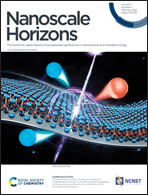
Nanoscale Horizons
Innovating Through Nanoscale Research ExcellenceNanoscale Horizons is an esteemed journal published by the Royal Society of Chemistry, focusing on cutting-edge research in the field of nanoscale materials and their applications. Established in 2016, this journal quickly gained prominence, achieving a Q1 ranking in Materials Science (miscellaneous) and a notable rank of #32 out of 463 in the Scopus index, placing it in the 93rd percentile among its peers. With its rigorous peer-review process and commitment to disseminating high-impact research, Nanoscale Horizons serves as a vital platform for sharing innovative discoveries and interdisciplinary advancements. Researchers and professionals are invited to explore the exciting developments in nanotechnology through this publication, fostering collaboration and knowledge exchange in an ever-evolving field. Though currently not open access, the journal ensures that significant research findings are made available to a diverse audience keen on advancing materials science.

Micro & Nano Letters
Fostering collaboration in micro and nano sciences.Micro & Nano Letters is a prominent open-access journal published by WILEY, dedicated to advancing the fields of micro and nanoscale science and technology. Since its inception in 2007, the journal has been a valuable resource for researchers, professionals, and students, delivering high-quality research that supports innovation and collaboration in bioengineering, biomedical engineering, condensed matter physics, materials science, and nanoscience. With an impact factor that reflects its growing influence, Micro & Nano Letters has earned recognition in various Scopus categories, including a Q3 ranking in both Condensed Matter Physics and Materials Science as of 2023. Its commitment to open access, established in 2021, ensures that the latest developments in micro- and nanotechnologies are accessible to a global audience, fostering a multidisciplinary dialogue across academia and industry. The journal continues to play a critical role in disseminating cutting-edge research and promoting technological advancements worldwide.
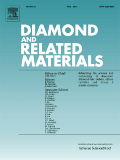
DIAMOND AND RELATED MATERIALS
Unlocking the potential of diamonds and their applications.DIAMOND AND RELATED MATERIALS, published by Elsevier Science SA, serves as a premier international platform for the dissemination of high-quality research in the fields of materials science, electrical engineering, and chemistry, with a specialized focus on diamond and its related materials. With an ISSN of 0925-9635 and an E-ISSN of 1879-0062, this journal has established itself within the top quartiles, reflecting its influential contribution to the scientific community, particularly in the categories of Chemistry (miscellaneous) and Electrical Engineering, among others. The journal's wide scope encompasses both theoretical and applied aspects of diamond research, making it an essential resource for professionals and academics alike. The current rankings position it favorably within its respective disciplines, with a notable 79th percentile in General Physics and Astronomy and strong standings in related categories. Although it does not offer open access, researchers can stay informed of cutting-edge advancements and methodologies through its comprehensive articles and reviews, enriching the wider discourse in advanced materials research.
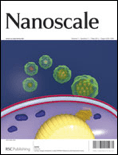
Nanoscale
Connecting Global Minds in Nanoscience.Nanoscale is a premier academic journal published by the Royal Society of Chemistry, dedicated to advancing the field of nanoscience and nanotechnology. With both its ISSN (2040-3364) and E-ISSN (2040-3372) ensuring wide accessibility, the journal is renowned for its high-impact research contributions, reflected in its impressive 2023 Impact Factor and prestigious Q1 ranking in both Materials Science (Miscellaneous) and Nanoscience and Nanotechnology categories. Since its inception in 2009, Nanoscale has fostered a collaborative platform where leading researchers from around the globe share their innovative findings across a multitude of topics spanning from material synthesis to applications in nanotechnology. The journal not only serves as a valuable resource for professionals, researchers, and students but also actively engages the academic community in discussing emerging trends, thus shaping the future of nanoscience. Situated in the heart of the UK at Thomas Graham House, Science Park, Milton Rd, Cambridge CB4 0WF, Nanoscale remains a key publication for those looking to keep abreast of the latest breakthroughs in an ever-evolving field.
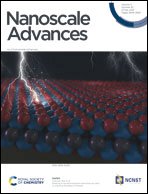
Nanoscale Advances
Advancing the Frontiers of Nanoscience.Nanoscale Advances, published by the Royal Society of Chemistry, stands out as a leading open-access journal dedicated to advancing the field of nanoscience and nanotechnology since its inception in 2018. With a specialized focus on areas such as atomic and molecular physics, bioengineering, chemistry, and materials science, this journal has consistently achieved top-tier rankings across several categories, reflecting its high-impact contribution to research and innovation. Currently classified in the Q1 quartile for both Atomic and Molecular Physics and Chemistry (Miscellaneous), and Q2 for Bioengineering, its prestige is underscored by impressive Scopus rankings, including a notable 34th position in General Engineering. With its commitment to disseminating high-quality research, Nanoscale Advances serves as an invaluable resource for researchers, professionals, and students alike, fostering collaboration and scholarly exchange in the rapidly evolving landscape of nanotechnology.

International Journal of Nanoelectronics and Materials
Championing innovative methodologies in material research.The International Journal of Nanoelectronics and Materials is a pivotal publication in the field of Nanoelectronics and Material Sciences, established by UNIMAP PRESS in Malaysia. With its ISSN 1985-5761 and E-ISSN 2232-1535, this journal has been providing a platform for innovative research and development since its inception in 2012 and is set to continue through 2024. Although categorized in the Q4 quartile for both Electrical and Electronic Engineering and Electronic, Optical and Magnetic Materials as of 2023, it presents an invaluable opportunity for authors to share their findings with a diverse audience while enhancing their academic visibility. The journal is accessible to a varied readership, including researchers, professionals, and students, emphasizing novel methodologies and applications in nanoelectronics technology and material science. It aims to foster scholarly communication and advance knowledge in these critical fields, making it an essential resource for those at the forefront of technological advancements.
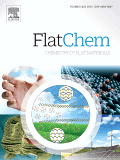
FlatChem
Championing Open Access for Groundbreaking Material ScienceFlatChem, an esteemed journal published by ELSEVIER, serves as a premier platform for disseminating high-quality research in the dynamic fields of ceramic and composite materials, electronic and optical materials, materials chemistry, and surfaces, coatings, and films. Since its inception in 2017, the journal has garnered a robust reputation, evidenced by its rank in the top quartile (Q1) across multiple categories, including a commendable rank of #25/127 in Ceramics and Composites and #49/284 in Electronic, Optical and Magnetic Materials. With a focus on pioneering advancements and innovative methodologies, FlatChem not only highlights cutting-edge research but also promotes collaboration and knowledge exchange within the scientific community. The journal’s impact is underscored by its impressive rankings in Scopus, marking it as a vital resource for researchers, professionals, and students aiming to stay at the forefront of materials science. As an open-access journal, it ensures that groundbreaking findings are readily accessible, fostering a broader understanding and application of materials innovation worldwide. The journal is based in the Netherlands, with its headquarters located at RADARWEG 29, 1043 NX AMSTERDAM, NETHERLANDS. Join the vibrant community contributing to FlatChem and engage with the forefront of material advancements.

Nanomaterials
Fostering Interdisciplinary Insights in NanotechnologyNanomaterials, published by MDPI in Switzerland, stands as a leading platform in the realm of materials science and chemical engineering. Since its inception in 2011, this Open Access journal has garnered significant attention, reflected in its impressive rankings—placing in the Q1 category for Chemical Engineering and Q2 for Materials Science as per the 2023 quartiles. The journal consistently fosters innovation and interdisciplinary research through its rigorous peer-reviewed articles, inviting submissions that span a wide range of topics from nanostructured materials to advanced engineering techniques. With a commendable Scopus rank—#44 in Chemical Engineering and #93 in Materials Science, both within the top percentiles—Nanomaterials serves as an essential resource for researchers, professionals, and students eager to stay abreast of developments in this rapidly evolving field. Since its establishment, it has distinctively contributed to the academic community by facilitating insightful knowledge exchange and promoting high-quality research around nanoscale materials.
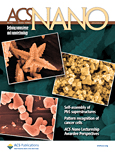
ACS Nano
Innovative Insights in Nanoscience and EngineeringACS Nano, published by the American Chemical Society, stands as a prestigious journal in the domains of Engineering, Materials Science, Nanoscience, and Physics. With an exceptional impact factor reflecting its standing as a Q1 category journal in multiple disciplines, it plays a pivotal role in disseminating groundbreaking research from 2007 to 2024. Known for its rigorous peer-review process, the journal boasts impressive Scopus rankings—positioned at #1 in General Engineering and #6 in General Physics and Astronomy—placing it among the top 1% of journals in its field. Although it is not an open-access publication, ACS Nano provides a wealth of knowledge that is essential for advancing the development of nanotechnology and its applications across various industries. Researchers, professionals, and students alike will find in its pages a trove of innovative studies and insights that drive the future of materials science and engineering.